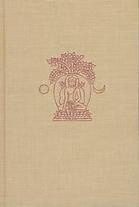
Bones, stones, and Buddhist monks : collected papers on the archaeology, epigraphy, and texts of monastic Buddhism in India PDF
Preview Bones, stones, and Buddhist monks : collected papers on the archaeology, epigraphy, and texts of monastic Buddhism in India
Bones, Stones, and Buddhist Monks Studies in the Buddhist Traditions a publication of the Institute for the Study of Buddhist Traditions University of Michigan Ann Arbor, Michigan Series Editor Luis O. Gómez University of Michigan, Ann Arbor Editorial Board Carl Bielefeldt Stanford University, Palo Alto Donald S. Lopez University of Michigan, Ann Arbor Gregory Schopen University of Texas, Austin Daniel Stevenson University of Kansas, Lawrence Studies in the Buddhist Traditions Bones, Stones, and Buddhist Monks Collected Papers on the Archaeology, Epigraphy, and Texts of Monastic Buddhism in India Gregory Schopen © 1997 University of Hawai'i Press All rights reserved Printed in the United States of America 97 98 99 00 01 02 5 4 3 2 1 The Institute for the Study of Buddhist Traditions is part of the Department of Asian Languages and Cultures at the University of Michigan, Ann Arbor, Michigan. It was founded in 1988 to foster research and publication in the study of Buddhism and of the cultures and literatures that represent it. In association with the University of Hawai'i Press, the Institute publishes the series Studies in the Buddhist Traditions, a series devoted to the publication of materials, translations, and monographs relevant to the study of Buddhist traditions, in particular as they radiate from the South Asian homeland. The series also publishes studies and conference volumes resulting from work carried out in affiliation with the Institute in Ann Arbor. Library of Congress Cataloging-in-Publication Data Schopen, Gregory. Bones, stones, and Buddhist monks : collected papers on the archaeology, epigraphy, and texts of monastic Buddhism in India / Gregory Schopen. p. cm. - (Studies in the Buddhist traditions ; 2) Includes index. ISBN 0-8248-1748-6 (cloth : alk. paper). - ISBN 0-8248-1870-9 (paper : alk. paper) 1. Monastic and religious life (Buddhism)-India. 2. Buddhist antiquities- India. 3. Buddhism-India-History. I. Series. BQ6160.14S36 1996 294.3'657'0954-DC20 96-30844 CIP University of Hawai'i Press books are printed on acid-free paper and meet the guidelines for permanence and durability of the Council on Library Resources Designed by Kenneth Miyamoto Dedicated to the taxpayers and working women and men of Canada and Australia who paid for this foreigner's education Contents Preface By Donald S. Lopez, Jr. ix Acknowledgments xi Abbreviations xv I. Archaeology and Protestant Presuppositions in the Study of Indian Buddhism 1 II. Two Problems in the History of Indian Buddhism: The Layman/Monk Distinction and the Doctrines of the Transference of Merit 23 III. Filial Piety and the Monk in the Practice of Indian Buddhism: A Question of "Sinicization" Viewed from the Other Side 56 IV. The Ritual Obligations and Donor Roles of Monks in the Pali * Vinaya 72 V. The Stupa* Cult and the Extant Pali Vinaya 86 VI. Monks and the Relic Cult in the Mahaparinibbana-sutta*: An Old Misunder- standing in Regard to Monastic Buddhism 99 VII. Burial Ad Sanctos and the Physical Presence of the Buddha in Early Indian Buddhism: A Study in the Archaeology of Religions 114 VIII. On the Buddha and His Bones: The Conception of a Relic in the Inscriptions from Nagarjunikonda* 148 IX. An Old Inscription from Amaravati* and the Cult of the Local Monastic Dead in Indian Buddhist Monasteries 165 X. On Avoiding Ghosts and Social Censure: Monastic Funerals in the Mulasarvasti vadavinaya * 204 XI. On Monks, Nuns, and "Vulgar" Practices: The Introduction of the Image Cult into Indian Buddhism 238 XII. The Buddha as an Owner of Property and Permanent Resident in Medieval Indian Monasteries 258 Index of Archaeological Sites and Inscriptions 291 Index of Texts 294 Index of Words, Phrases, and Formulae 296 Index of Subjects 298 PREFACE THE COLLEGIATE INSTITUTE for the Study ofBuddhist Traditions of the Univer sity of Michigan is very pleased to be able to present this collection of papers by Professor Gregory Schopen as the second volume in its series. Through his meticulous studies of a wide range of neglected or forgotten sources, many of which are carved in stone, Professor Schopen has effected a major shift in the direction of Buddhist Studies, a shift away from the sometimes excessive focus upon the rarefied categories of the scholastic ptoductions by monastic elites, and a shift toward a recognition of the importance of the materiality of "popular" practice. These practices not only occupied the concerns of a much larger segment of the Buddhist communities of India, both monastic and lay, but served as the inevitable context for the formulation and elaborat ion of scholastic doctrine. Professor Schopen's work, published over the last fifteen years in a wide range of scholarly journals, has been focused btoadly on two issues in the history of Indian Buddhism: monastic life and the rise of the various movements that we refer to as the Mahäyäna. Monastic Buddhism in India is the subject of the current volume. Ptofessor Schopen's highly influential papers on the rise of the Mahäyäna, which have called into question both the coherence of the category as weIl as its date, are currently being edited for publication as the next volume . . m our senes. The present volume provides an essential foundation for a social history of Indian Buddhist monasticism. Challenging the popular stereotype that repre sented the accumulation of merit as the domain of the layperson while monks concerned themselves with more sophisticated realms of doctrine and meditation, Professor Schopen problematizes many assumptions about the lay-monastic dis tinction by demonstrating that monks and nuns, both the scholastic elites and the less learned, participated actively in a wide range of ritual practices and institutions that have heretofore been judged "popular," from the accumulation lX
